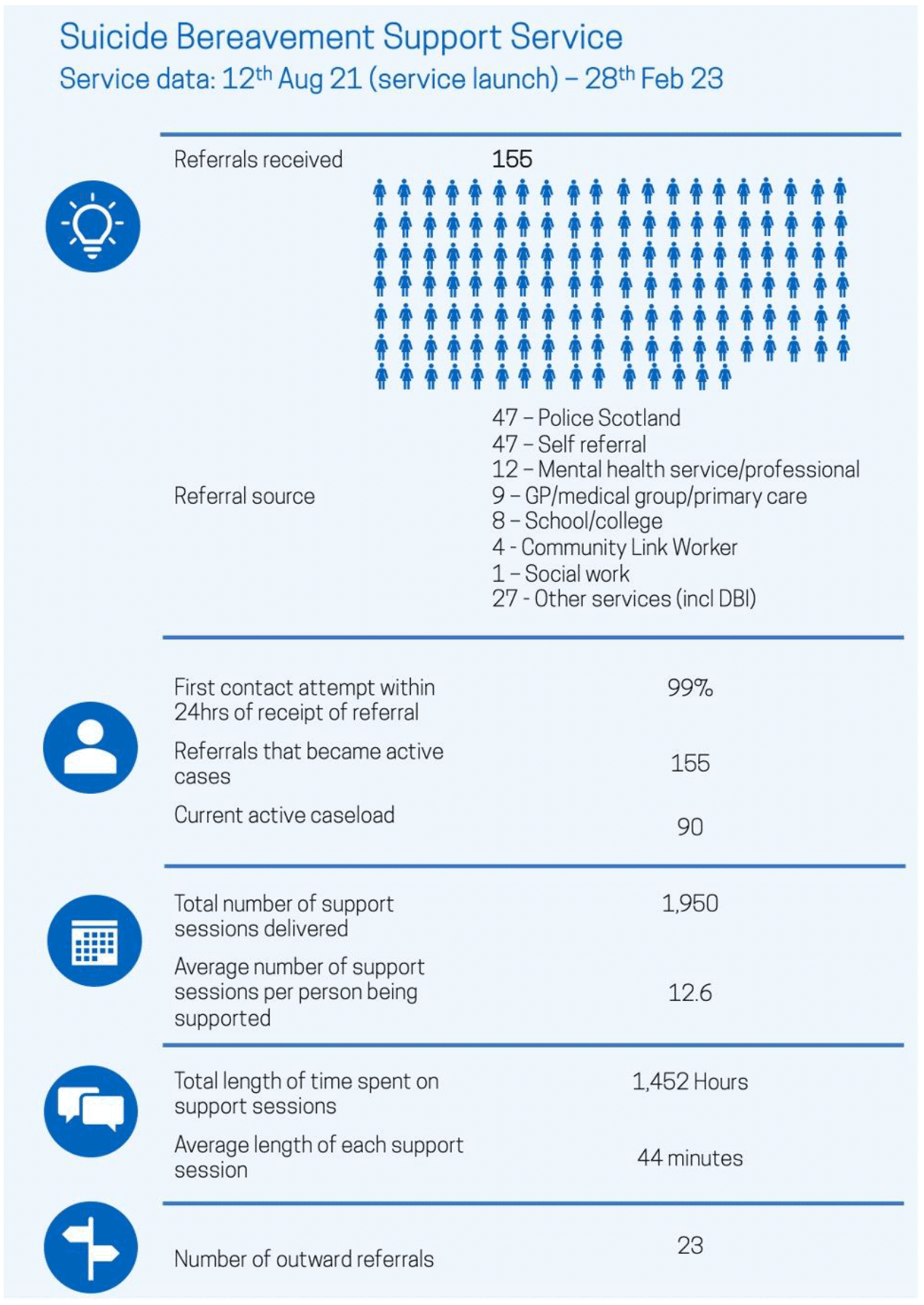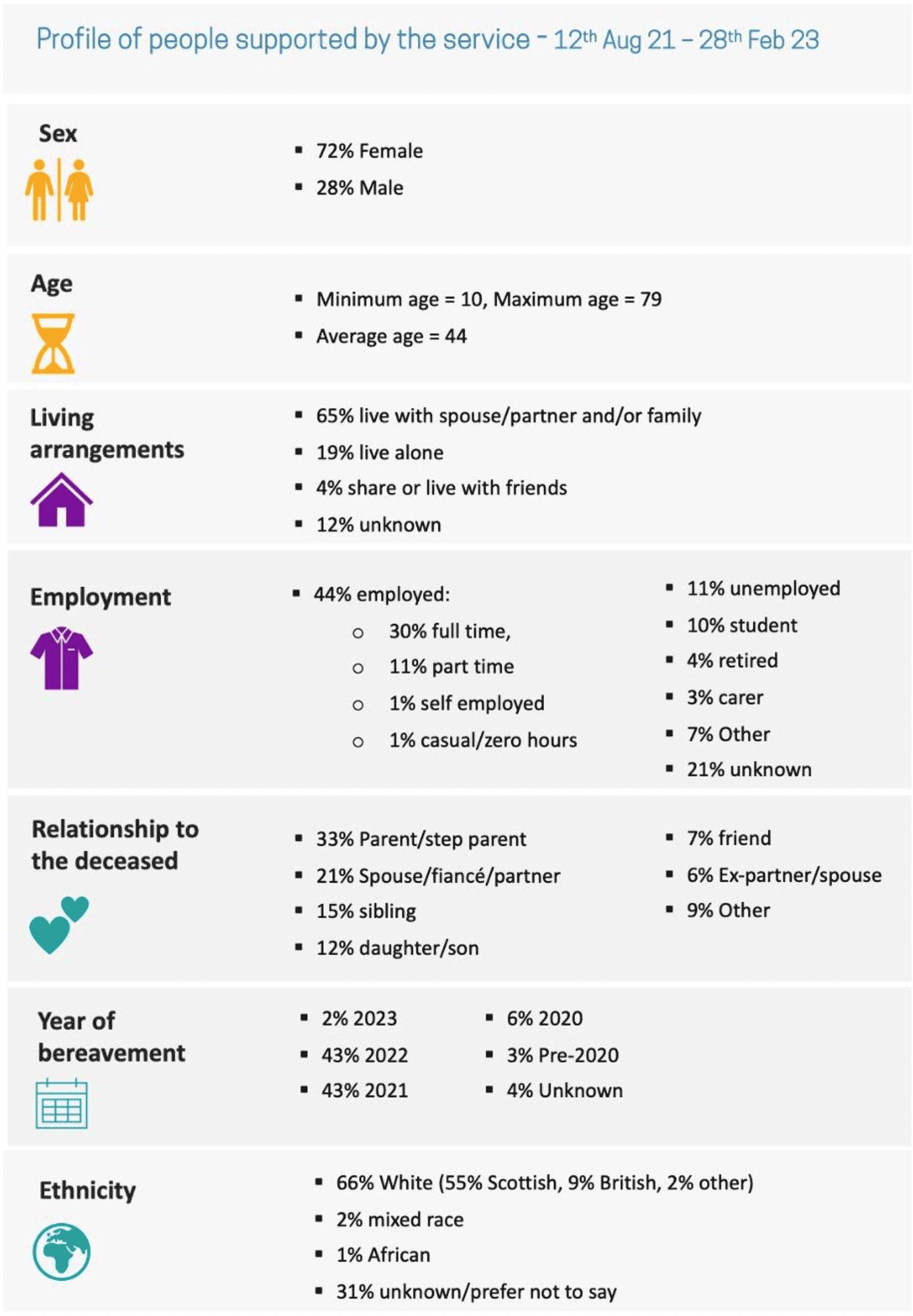Suicide Bereavement Support Service: evaluation report - year 2
This report covers Year 2 of the multi-year evaluation of the Suicide Bereavement Support Service (SBSS). It draws on two years of the evaluation to date while also providing additional learning and evidence on experiences and outcomes.
3. Service activity and people supported
This chapter provides an overview of service delivery activity and a profile of the people supported by the SBSS.
3.1 Overview of service activity
The infographic below sets out the monitoring data covering the period since the service launched in August 2021 to the end of February 2023.

Number of people supported, and support sessions delivered
The SBSS received 155 referrals over 19 months of delivery, an average of eight referrals per month. This represents a decrease from previous reporting points where the monthly average was ten (as of April 2022, after eight months of delivery or nine (as of August 2022, after 13 months of delivery). Since September 2022, SBSS has received 33 referrals (25 Ayrshire and Arran, eight Highland), an average of only five per month, indicating a slowdown in referral activity, particularly in Highland.
At the end of February 2023, 90 people were receiving support from the service, with 53 in Ayrshire and Arran and 37 in Highland. Active cases increased at each reporting point across the evaluation (64 in March 2022 and 78 in August 2022).
A total of 1,950 support sessions, and 1,452 hours of support, have been provided using a mix of telephone, video call, text message and face-to-face delivery, with most support sessions being delivered over telephone or video call. This equates to an average of 12.5 sessions per person being supported, each lasting an average of 44 minutes. Across the two areas, Ayrshire and Arran delivered more support sessions, reflecting their larger caseload. The average number of sessions per person being supported and the average length of support sessions are broadly similar across both areas.
Inward referrals
Self-referral and referrals from Police Scotland account for just under two-thirds (61%) of all referrals received by the SBSS. This differs across each service area, with those referral pathways accounting for 45% of total referrals received in Ayrshire and Arran and 77% in Highland. However, since the last reporting point in September 2022, these referral pathways have been less active in both areas. In the six months between September 2022 to February 2023, the service in Ayrshire and Arran received four referrals from Police Scotland and three self-referrals; during the same period, Highland received only one referral from Police Scotland and two self-referrals. In the past 12 months, the service carried out activities to raise awareness and establish new pathways, resulting in a wider variety of referral sources.
Outward referrals
The data demonstrates that there has been a low level of outward referral activity, with nine in Ayrshire and Arran and 14 in Highland. This is not surprising given the feedback we have received from people supported by the SBSS who feel their practical and emotional needs are being met by the service. However, signposting to resources and sources of information relevant to people’s needs does happen more frequently.
3.2 People supported
The infographic below sets out a profile of people supported by the SBSS.

Link to detailed description of infographic content
Differences in the profile of people supported across the service delivery areas
While the following information is presented for each pilot area, it is important to note that this is not to draw comparisons. It is being presented in this way to demonstrate the differences and similarities in the profile of people accessing the service in each area:
- Sex – in Ayrshire and Arran, the split has remained consistent (roughly 25% men, 75% women), while the proportion of women in Highland has increased. More men have accessed the service in Highland (32%).
- Age – the average age of supported people is lower in Ayrshire and Arran (41) than in Highland (46).
- Living arrangements –very little difference across the two areas, with most people receiving support living with a spouse, partner or family.
- Employment – the high proportion of ‘unknown’ in Ayrshire and Arran and a similar proportion of ‘unknown’ or ‘other’ in Highland does not allow for an accurate observation of any differences across the two areas.
- Relationship to the deceased – Highland supported a higher proportion of parents and children. Ayrshire and Arran have higher proportions of spouses/fiancé/partners and siblings that have accessed the service.
- Year of bereavement – the breakdown is broadly similar across the two areas, with most bereavements occurring in 2021 and 2022 (84% in Ayrshire and Arran and 88% in Highland). In Highland, a slightly higher proportion of supported people were bereaved by suicide before 2020, whereas in Ayrshire and Arran, a slightly higher proportion experienced a bereavement in 2020.
- Ethnicity – the high proportion of ‘unknown/prefer not to say’ in the service data from Ayrshire and Arran does not allow for any differences to be observed.
Differences over time in the profile of people supported by the SBSS
Some changes over time are evident when this year’s profile data is compared with the profile data as of March 2022:
- Sex – the male/female split has remained consistent in Ayrshire and Arran (roughly 25% male, 75% female), while in Highland, the proportion of females accessing the service has increased from 60% to 68%.
- Age – the average age of supported people has lowered slightly from 44 to 41, while in Highland, it increased from 40 to 47. This likely reflects the higher proportion of parents/stepparents accessing support in Highland and the higher proportion of siblings supported in Ayrshire and Arran.
- Relationship to the deceased – most supported people are immediate family members of the deceased. While this has remained consistent during the pilot, there has been some variation in relationship type. The proportion of parents/step-parents in Ayrshire and Arran has increased from 6% to 27%, and there has also been an increase in spouses/partners, from 16% to 22%. There has been a 10% decrease in the proportion of children of the deceased, from 16% to 6%. In Highland, the profile regarding the relationship with the deceased has not changed significantly.
- Year of bereavement – unsurprisingly, the proportion of supported people that experienced a bereavement in 2022 increased across both service areas. There has been no change in the number of supported people who experienced a bereavement before 2020, suggesting those accessing the service are doing so following a more recent bereavement.
3.3 Reflections on the data collected by the service
The completeness and consistency of data have steadily improved across the evaluation duration as data collection processes have become embedded. There remain a small number of inconsistencies in how some demographic data is categorised, specifically information about employment status and the supported person’s relationship to the deceased. Data on service activity and demographics are recorded in each delivery area but not yet routinely compiled at an overall service level.
Contact
Email: socialresearch@gov.scot
There is a problem
Thanks for your feedback